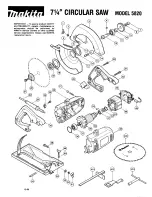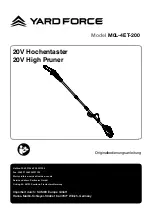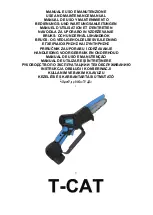
7 in. Portable Tile Saw
7
For technical questions call: 1-800-665-8685
V 2.0
8436776
EXTENSION CORD
1. Use a single extension cord that is the correct length and gauge that matches or exceeds the amperage rating
of the tool. Using multiple extension cords, a cord that is too long or an insufficient gauge can cause the
following hazards:
a.
Fire from overheating. Unroll the cord completely to prevent it from overheating and damaging
the insulation.
b.
Electric shock from melting or damaging the cord’s insulation.
c.
Underpowering the tool causing a functional failure, resulting in personal injury or damage the tool.
d.
A cord that is too long may create a tripping hazard to others moving within the work area.
2. Use the tool without an extension cord whenever possible. Only use an extension cord as a temporary means
of reaching the power supply.
3. When operating a power tool outside, use an outdoor extension cord marked ‘W-A’ or ‘W’. These cords are
rated for outdoor use. Constructed of more durable materials, they can withstand temperature changes, UV light
(sunlight) and moisture, reducing the risk of electric shock.
4. Use in conjunction with a Ground Fault Circuit Interrupter (GFCI). If operating a power tool in a damp location
is unavoidable, the use of a GFCI reduces the risk of electric shock. It is recommended that the GFCI should
have a rated residual current of 30 mA or less.
LOW VOLTAGE
Low voltage may cause overheating due to higher power current being drawn to the tool that will shorten the
motor life.
An extension cord may cause a drop in power to the tool if too long or the amperage rating is not correct. This may
result in the following:
• The tool will not activate when switched on.
• The tool may switch on, but fails to maintain power when applied to a workpiece.
• The tool may overheat, possibly starting a fire.
Test the tool by plugging it directly to the power supply. If it powers on, change the extension cord with the correct
rating and as short as needed. The workpiece may also need to be relocated closer to the power supply.
KICKBACK PRECAUTIONS
Kickback is a sudden reaction to a pinched or snagged rotating wheel, backing pad, brush or other accessory. The
edge of the wheel enters the pinch point and digs into the material, kicking the workpiece out in the direction of the
accessory’s rotation.
Maintaining a firm grip on the workpiece and positioning your body and arms to resist the kickback.
Summary of Contents for bd4600
Page 1: ...User Manual 8436776 V 2 0 7 in Portable Tile Saw Please read this manual before use ...
Page 2: ......
Page 14: ......
Page 16: ......
Page 28: ......








































